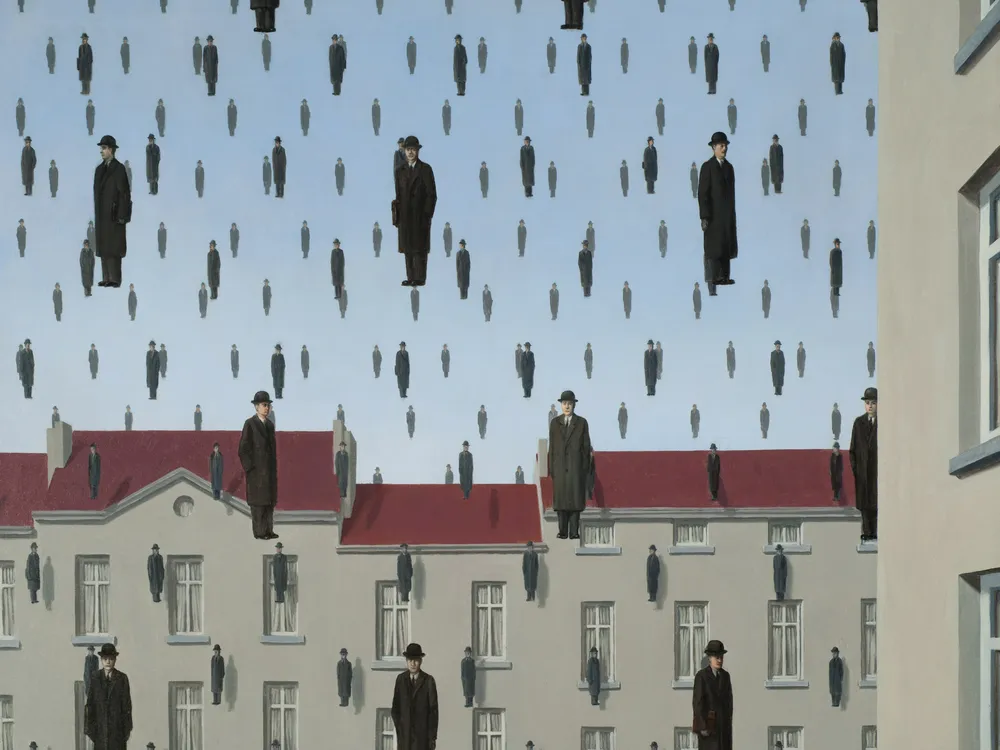The Art Gallery of New South Wales’ new exhibition offers a rare opportunity to explore René Magritte’s surrealist work through four decades of artistic evolution. Known for his dreamlike, paradoxical paintings, Magritte’s work challenges viewers to question reality and their own perceptions. From his iconic motifs—like the apple, pipe, and bowler hat—to lesser-known pieces, this exhibition captures how Magritte’s vision of the surreal matured over time, offering a retrospective that is as challenging as it is enchanting.
This critical essay will explore how Magritte’s work evolved, examining the themes, techniques, and recurring symbols that define his unique take on surrealism. Through his paintings, Magritte drew the viewer into a world where ordinary objects became extraordinary, forcing us to confront the limits of our own reality. This exhibition is not just a celebration of Magritte’s artistry but a journey into the psychological depths of the human mind.
Magritte’s journey into surrealism began in the early 1920s, during a period marked by social and political upheaval. Surrealism, with its roots in Freudian psychoanalysis and a desire to liberate the subconscious, provided Magritte with the perfect medium to explore his fascination with reality and illusion. Early influences like Giorgio de Chirico and André Breton introduced Magritte to surrealism’s aesthetic, but his work would soon diverge, reflecting his unique perspective.
Magritte’s early works are characterized by a blend of illusion and reality that challenges the viewer’s perception. His painting “The Lost Jockey” (1926) exemplifies his initial exploration of these themes, presenting a surreal landscape where objects defy logic. The Art Gallery of New South Wales’ exhibition includes several early pieces that show Magritte’s experimentation with form and juxtaposition. This phase of his work represents a foundational period where he developed the visual language that would come to define his mature style.
One of the most compelling aspects of Magritte’s work is his use of ordinary objects—apples, pipes, bowler hats—to create a sense of mystery. These symbols became hallmarks of Magritte’s work, recurring across different periods and evolving in meaning. His famous “The Treachery of Images” (1929), which depicts a pipe alongside the phrase “Ceci n’est pas une pipe” (“This is not a pipe”), confronts the viewer with the difference between an object and its representation. This work is central to understanding Magritte’s philosophy, as it challenges the idea that images can fully capture reality.
Magritte’s bowler-hatted men, often faceless and placed against vast, surreal landscapes, create a sense of anonymity and universality. In “The Son of Man” (1964), the figure’s face is obscured by an apple, a motif that symbolizes the tension between visibility and concealment, identity and mystery. This exhibition provides a rich look at how these motifs developed over time, evolving in complexity and significance. Through his repetition of these symbols, Magritte forces the viewer to question what lies beneath the surface of familiar objects and challenges our instinct to categorize and label the world.
Philosophy played a significant role in Magritte’s approach to art, especially as he began to explore themes of perception and truth. His paintings are often described as visual philosophy, as they challenge the viewer’s assumptions about reality. Influenced by thinkers like Michel Foucault, Magritte sought to use art as a means to explore the limitations of human understanding. His works invite viewers to question not only the nature of reality but also the limitations of language and symbols.
For instance, “The Human Condition” series depicts landscapes painted within windows, blurring the line between image and reality. The objects are positioned in such a way that they blend seamlessly with the landscape behind them, creating an illusion of continuity. This technique reflects Magritte’s view that our understanding of reality is shaped by our perspective. By layering images within images, he challenges the idea of a singular “truth,” suggesting instead that reality is subjective and multifaceted.
Over his four-decade career, Magritte’s style evolved significantly, moving from sharply defined realism to softer, almost impressionistic treatments in his later years. This stylistic progression mirrors his deepening exploration of psychological and philosophical themes. His early work is marked by crisp lines and a muted color palette, emphasizing the contrast between ordinary objects and surreal contexts. In works like *The Lovers* (1928), the clarity of form draws attention to the paradoxes within his compositions.
In the 1950s and 60s, however, Magritte’s palette began to shift, incorporating more vibrant colors and looser brushstrokes. This period, known as his “Renoir Period,” was inspired by his admiration for Impressionism and the need to introduce warmth and spontaneity into his work. *The Empire of Light* series, for example, juxtaposes daytime skies with nocturnal landscapes, creating an ethereal, dreamlike quality. The exhibition showcases this progression in Magritte’s technique, providing insight into how his artistic vision expanded and deepened over time.
This shift in style allowed Magritte to explore new dimensions of surrealism, bringing a more introspective quality to his later works. By incorporating softer, more vibrant hues, he imbued his paintings with a sense of tranquility and introspection, contrasting sharply with the stark, cerebral nature of his earlier work. This evolution reflects Magritte’s own journey as an artist, as he sought to capture not only the mysteries of the external world but also the complexities of the human psyche.
While Magritte is best known for his iconic motifs, this exhibition also includes several lesser-known works that reveal the diversity of his artistic vision. Pieces like “The Philosopher’s Lamp” (1936) and “The Explanation” (1952) offer a glimpse into Magritte’s experimental side, showing how he used surrealism to explore abstract concepts like thought, desire, and time. These works are less direct than his famous pieces but no less powerful in their impact.
For instance, “The Philosopher’s Lamp” presents a man with a candle extending from his nose, symbolizing the search for knowledge and the limitations of human perception. By including such works, the Art Gallery of New South Wales broadens our understanding of Magritte’s repertoire, showing that his work goes beyond familiar symbols to encompass a wide range of ideas and emotions. This comprehensive approach allows visitors to appreciate the full scope of Magritte’s creativity, highlighting the depth and diversity of his contributions to surrealism.
René Magritte’s influence extends far beyond the art world, shaping popular culture, advertising, and even philosophy. His work has inspired countless artists, filmmakers, and writers, and his approach to surrealism remains as relevant today as it was during his lifetime. Magritte’s ability to make the familiar strange and the strange familiar has had a profound impact on how we understand the relationship between reality and imagination.
In this exhibition, Magritte’s legacy is presented not only as an art form but as a way of seeing the world. His work encourages viewers to question their assumptions, to look beyond the surface, and to embrace the unknown. By confronting the paradoxes of existence, Magritte invites us to explore our own subconscious, to confront our fears, and to celebrate the mystery of life. His legacy lives on in the works of contemporary artists who continue to explore themes of perception, reality, and illusion.
The Art Gallery of New South Wales’ exhibition offers an in-depth look at René Magritte’s evolution as an artist, capturing the breadth and depth of his surrealist vision. Through four decades of work, Magritte remained committed to exploring the boundaries of perception, challenging us to question what we see and what we know. His use of ordinary objects as symbols of deeper meaning reveals his belief in the power of the imagination to transform reality.
As viewers walk through this exhibition, they are invited to embark on a journey into the unknown, guided by Magritte’s unique perspective on life and art. His paintings serve as windows into the subconscious, reflecting our own dreams, fears, and desires. This exhibition is more than a collection of paintings; it’s an invitation to explore the depths of the human psyche and to embrace the mysteries that define our existence. René Magritte’s work endures because it speaks to something universal—a desire to see beyond appearances and to find meaning in the inexplicable.
In celebrating Magritte’s legacy, this exhibition reminds us that art has the power to challenge, to inspire, and to reveal truths that lie beyond the surface. Magritte’s work continues to captivate audiences, not because it provides answers, but because it invites us to keep asking questions.
No comments yet.








